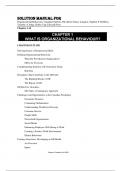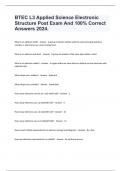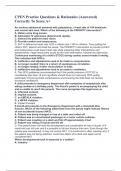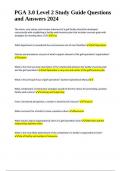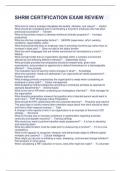Pearson Canada Inc.© 2023 Solution Manual For Organizational Behaviour, Canadian Edition, 9th edition Nancy Langton, Stephen P. Robbins, Timothy A Judge, Robin Yap, Edward Perry Chapter 1 -14 CHAPTER OUTLINE The Importance of Interpersonal Skills Defining Organizational Behaviour What Do We Mean by Organization? OB Is for Everyone Complementing Intuition with Systematic Study Big Data Disciplines That Contribute to the OB Field The Building Blocks of OB The Rigour of OB OB Has Few Absolutes OB Takes a Contingency Approach Challenges and Opportunities in the Canadian Workplace Economic Pressures Continuing Globalization Understanding Workforce Diversity Customer Service People Skills Networked Organizations Social Media Enhancing Employee Well -Being at Work Creating a Positive Work Environment Ethical Behaviour Coming Attractions: Developing an OB Model An O verview Inputs Pearson Canada Inc.© 2023 Processes Outcomes Summary OB at Work LEARNING OUTCOMES 1. Demonstrate the importance of interpersonal skills in the workplace. 2. Define organizational behavior (OB). 3. Demonstrate why few absolutes apply to OB. 4. Understand the value of systematic study to OB. 5. Identify the major behavioural science disciplines that contribute to OB. 6. Identify workplace challenges that provide opportunities to apply OB concepts. 7. Describe the three levels of analysis in this book‘s OB model CHAPTER SYNOPSIS This chapter demonstrates the practical value of OB concepts, defines the field, and identifies current topics in OB. The chapter begins by citing evidence that the workplace of the twenty -first centuries requires individuals who will take on more respon sibility and who also want more out of their jobs. The chapter also presents evidence showing that managing well makes a difference. The authors discuss how the systematic study of OB uses scientific evidence to attribute causes and effects. OB studies ind ividuals, groups, and structure to understand human behaviour and its link to organizational effectiveness. The chapter takes a detailed look at the current challenges in the Canadian workplace. The chapter concludes with a general model that defines the f ield of OB. STUDY QUESTIONS It is impossible to cover all the material contained in the chapter during one or two lectures. To deal with this problem, I present my students with a list of study questions to indicate what material they will be responsible for on exams. I tell them that they will be responsible for these, even if the material is not covered in class. I have found that this reduces anxiety overall, and I find it helps to make students aware that not everything in a chapter is required materi al. I realize instructors vary in their approach, so this is simply my approach. My study questions for this chapter are: What is OB? How does OB make sense of behaviour? What is empowerment? What does it mean to say that OB takes a contingency approa ch? Pearson Canada Inc.© 2023 What are the challenges for OB in the 21st century? What skills are needed for the New Workplace ? What is the ―Competing Values Framework‖? What kinds of skills does the Competing Values Framework suggest are useful for individuals to have? How do these skills link up with the activities and needs of today‘s organizations? SUGGESTED TEACHING PLAN I spend two days covering this material. On the opening day of class, I mainly take the students through the syllabus, outlining topics, expectations and test (and other important) dates. I introduce them to the basics of OB. I then ask the students to form groups of about 6. These small groups are instructed to develop interview questions that they will then pose to me. After giving the students 15 mi nutes to develop their questions, the interviews begin. Each group asks one question, and when all of the groups have asked one question, round two begins. Students are told that they may ask any and all questions about anything, and I will try to answer. We continue the rounds until the questions run out. The students ask a mixture of course -related and ―personal‖ questions, though they have always been respectful. I like the exercise because it signals openness at the very start of the term. I remind them the next day that no one fainted when they asked questions, so they should continue to participate in class. On the second day of class, I continue with the introduction to OB material, emphasizing the Competing Values Framework, which is covered in From Concepts to Skills at the end of the chapter. Half of my class time would be devoted to doing the Experiential Exercise to help students understand the Competing Values Framework. I do this to highlight the importance of acquiring interpersonal skills in order to be a successful employee. Our course has a defined interpersonal skills component to it, thus the emphasis at the beginning of the course for why these skills are important. Be sure to check the Supplemental Material section for additional material that can be used in class or assigned as homework. SAMPLE LECTURE OUTLINE The Importance of Interpersonal Skills In today‘s increasingly competitive and demanding workplace, individuals need to have good people skills. Managers may get by on their technical skills for a while, but leadership and communication skills affect career success. Pearson Canada Inc.© 2023 Teaching Tip: This is a good place to turn to the Experiential Exercise: Developing Interpersonal Skills. Students could be assigned homework reading of pp. 27. Defining Organizational Behaviour Organizational behaviour is a field of study that investigates the impact that individuals, groups, and structure have on behaviour within organizations; its purpose is to apply such knowledge toward improving an organization‘s effectiveness. OB is concerned with the study of what people do in an organization and how that behaviour affects the performance of the organization. OB inc ludes the topics of motivation, leadership, power, interpersonal communication, group structure and processes, learning, attitude development and perception, change processes, conflict, work design, and work stress. Teaching Tip : Spend some time with the students trying to explain to them why studying this material is really important to them. I do this by reminding them they will be working in groups during the term, and that they will learn a variety of concepts that will help them deal with group issues . I also remind them that almost everything they do —school, church, work, volunteer activities —gives them opportunities to see OB in action. What Do We Mean by Organization? A consciously coordinated social unit composed of a group of people, which func tions on a relatively continuous basis to achieve a common goal or set of goals. Manufacturing and service firms are organizations, and so are schools, hospitals, churches, military units, retail stores, police departments, volunteer organizations, start -ups, and local, state and federal government agencies. Organizations can be located in the public sector or the private sector, they can be unionized or not, they can be publicly traded or they can be privately held. If organizations are publicly traded, senior managers typically are responsible to a board of directors, which may or may not take an active role in the how the firm is run. If the firm is privately held, it may be run by the owners or the managers report to the owners. Firms can also opera te in the for -profit or the non -profit sector. All of these facts, taken as a whole, should suggest that when one thinks of an organization, the likelihood that it is a ―typical‖ organization is small. Teaching Tip: The main point you want to make here i s that when students think of organizations, they‘re often thinking of large organizations. But, the material applies to organizations of any size, and most people work in small organizations.

